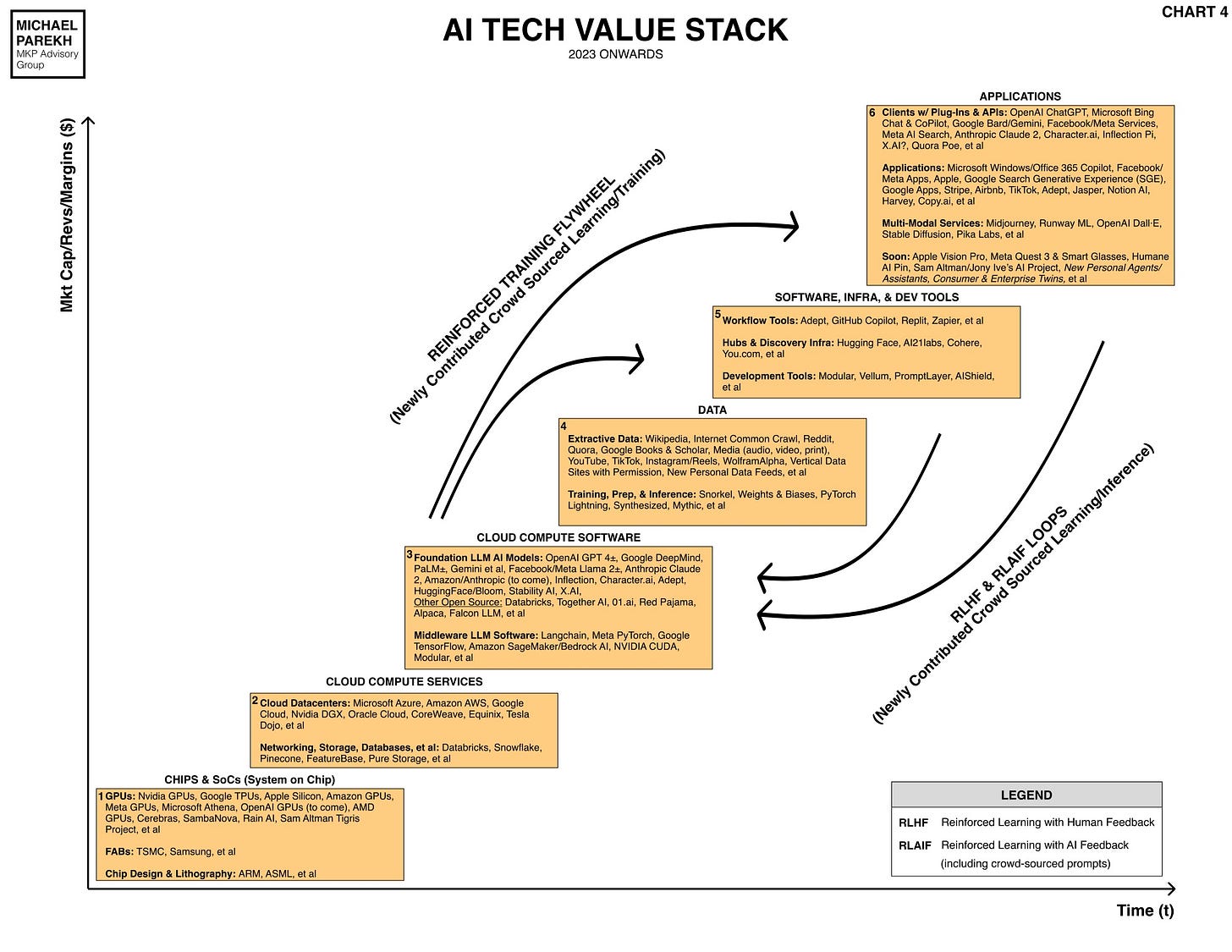The Bigger Picture, Sunday December 10, 2023
I’ve said for a long time, and in many pieces here at AI: Reset to Zero that technology generally takes longer than the promises exciting society in the early years. And then when it finally happens and truly goes natively mainstream, it seems to happen faster than we all then expect. And in the early years, the gold rush spending generally costs ways more than generally lower than expected demand initially.
I made this point recently about internet commercialization, self-driving cars, and other tech initiatives over the last few decades. The Bigger Picture this Sunday is that it will likely happen with the current AI Tech Wave too. What brought it home to me vividly was a new piece taking a deeper look at where we are with the 5G tech wave today vs expectations just a few years ago. Let me unpack.
Allison Johnson at the Verge notes in an in-depth piece on the race to 5G and where we are today vs expectations not too long ago:
“Networks spent years telling us that 5G would change everything. But the flashiest use cases are nowhere to be found — and the race to deploy the tech was costly in more ways than one.”
“At CES in 2021, 5G was just about everywhere you looked. It was the future of mobile communications that would propel autonomous vehicles, remote surgery, and AR into reality. The low latency! The capacity! It’ll change everything, we were told. Verizon and AT&T wrote massive checks for new spectrum licenses, and T-Mobile swallowed another network whole because it was very important to make the 5G future happen as quickly as possible and win the race.”
“CES 2024 is just around the corner, and while telecom executives were eager to shout about 5G to the rafters just a few years ago, you’ll probably be lucky to hear so much as a whisper about it this time around. While it’s true that 5G has actually arrived, the fantastic use cases we heard about years ago haven’t materialized. Instead, we have happy Swifties streaming concert footage and a new way to get internet to your home router. These aren’t bad things! But deploying 5G at the breakneck speeds required to win an imaginary race resulted in one fewer major wireless carrier to choose from and lots of debt to repay. Now, network operators are looking high and low for every bit of profit they can drum up — including our wallets.”
The piece goes into detail how the oligopolistic telco carrier industry in the US, lead by Verizon, T-Mobile and AT&T spent billions ahead of the demand curve to move from 4G to 5G, with the promise of wired broadband (aka fiber) types of internet speeds with minimal latency.
What they found, especially for Verizon with the more specialized super high speed part of the 5G spectrum, is that the technology had trouble transmitting through walls at scale, and in many places delivered speeds no better than 4G. And the applications we use wireless broadband for didn’t scale as much as we dreamed they would.
Especially in vertical fields like healthcare (remote surgeries etc.), industrial automation, education etc. What the companies found was that those vertical domains required substantial customized technology, marketing and support infrastructure investment that was deemed impractical as they race to turn the dreams into reality.
If all this rings bells for the promises and dreams of the current AI Tech Wave, it’s no accident. History does rhyme. Every magazine article, tech cocktail party and boardroom discussion goes on about how AI will fundamentally reshape Healthcare, Education, Manufacturing, Robotics, Finance and so many other vertical industries.
And they will over time.
But it’s important to distinguish behind two aspects of any new technology that promises benefits over the preceding one, Augmentation vs Native applications and services.
Most of the applications and services of the new technology in the holy grail Box no. 6 in the AI Tech Wave chart above, is around Augmentation. Applying the new technologies to make existing products and services ‘new and improved’. And potentially charging higher prices for the same if the industry continues to have oligopolistic and/or ‘regulatory capture’. Augmented AI applications are what most businesses in every industry will spend billions over years figuring out how to do well. It will take time. It’s AI software being applied over traditional software customized for those industries and their incumbent ecosystems.
The promises that capture our imaginations in the early days of these technologies are the ‘Native’ products or services built from them. They’re the ones that get on the magazine covers (OpenAI’s ChatGPT as an example), and take the world by storm. But they take longer to emerge and catch on. Sometimes a decade or more. Think Crypto, Internet of Things (aka IoT), actually auto driving cars, and so many more technology holy grails. We’re still waiting for mainstream applications at scale.
The other big picture around this discussion is that we these early technology dreams also empower our fears.
So they get wrapped up in our geopolitics, trades policies, regulations, and just general societal caution ahead of the augmented and native realities of the technologies. Whenever they come about.
Remember how 5G even to this day drives our geopolitical wrangling with China. Just like AI is doing today. This bit is not addressed in the excellent dive into 5G by Allison at the Verge. But worth thinking about as we live through the AI Tech Wave.
Making these distinctions and managing our expectations around technology best positions us as consumers, investors and ultimate beneficiaries of these technologies. Be they augmented or native. It’s all good stuff to look forward to. That’s the Bigger Picture. Enjoy your Sunday. Stay tuned.
(NOTE: The discussions here are for information purposes only, and not meant as investment advice at any time. Thanks for joining us here)






